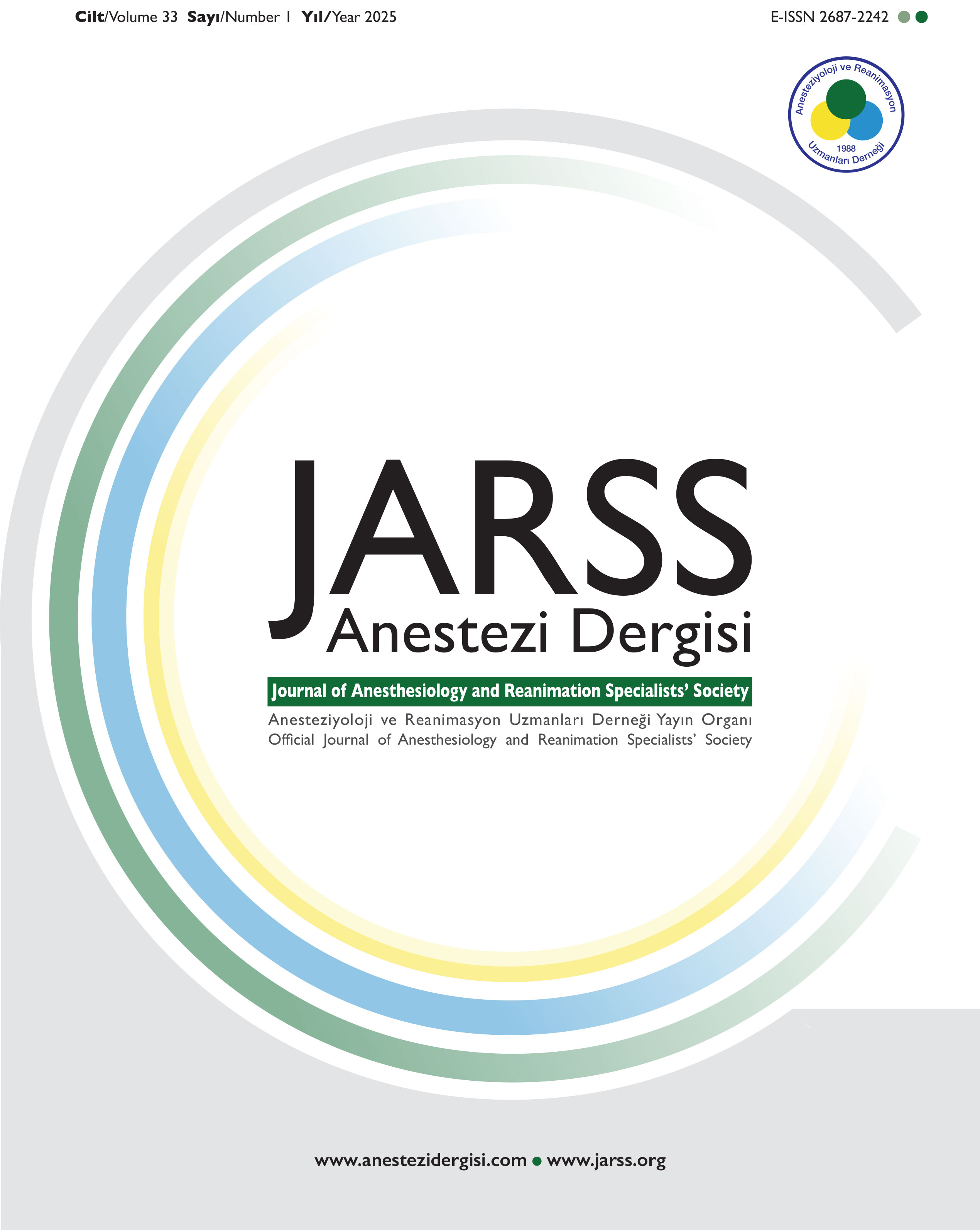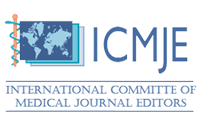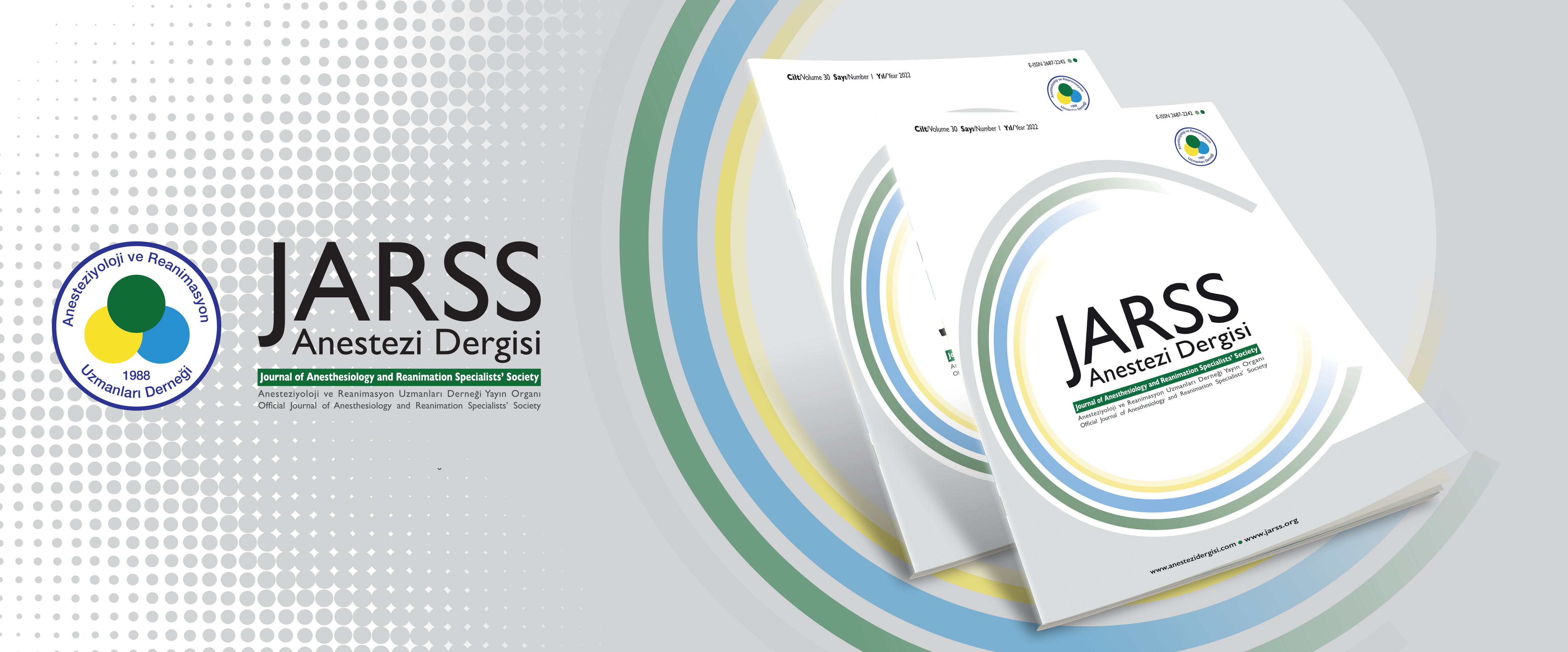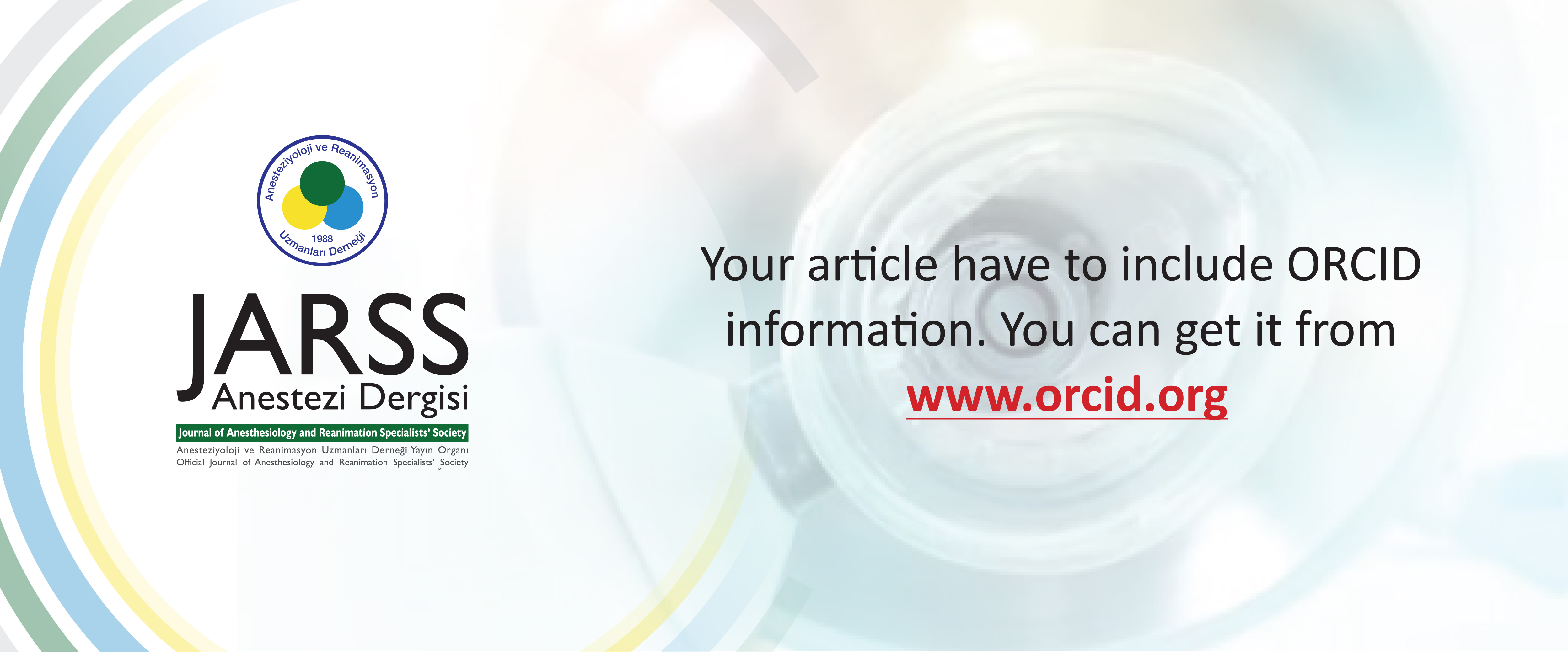Volume: 30 Issue: 4 - 2022
| 1. | Cover Page I (400 accesses) |
| 2. | Advisory Board Pages II - IV (808 accesses) |
| 3. | Contents Pages V - VI (308 accesses) |
| REVIEW | |
| 4. | Critical Illness in Pregnancy and Intensive Care Banu Kılıçaslan doi: 10.54875/jarss.2022.48403 Pages 213 - 224 (884 accesses) Pregnant women may require Intensive Care Unit (ICU) at any stage of pregnancy for “obstetric” or “non-obstetric” causes. Many clinical situations can develop during pregnancy, such as hypertensive diseases, bleeding, venous thromboembolism, endocrine diseases, asthma, epilepsy, infection, and sepsis, which are common and require special management, however may not be critical. Most pregnancies with these complications have uneventful outcomes for both mother and fetus. Of 1-3% pregnancies with critical diseases require ICU care. Obstetric bleeding and hypertensive diseases are responsible for 55% of ICU admissions. However, the growing fetus is completely dependent on the mother for oxygenation, nutrition, and removal of other waste products. This “second guest” is always considered in the management of the pregnant patient. Optimal management of the mother often constitutes the best treatment for the fetus. It mostly involves multidisciplinary treatment by obstetricians, pediatricians, and anesthesiologists. During the pregnancy follow-up, delivery of the fetus may be necessary for maternal or fetal indications and should be planned. In this article, the determination of the physiological goals of the pregnant patient in the ICU, the general care principles, the follow-up of the treatment, and the follow-up of the fetus during all these stages will be discussed. |
| ORIGINAL RESEARCH | |
| 5. | Retrospective Comparison of the Efficacy of Pulsed Radiofrequency of the Suprascapular Nerve and Combined Transcutaneous Radiofrequency Techniques in Supraspinatus Tendinopathies Çiğdem Yalçın, Güldane Karabakan doi: 10.54875/jarss.2022.17362 Pages 225 - 231 (507 accesses) Objective: Pain in supraspinatus tendinopathy can often be reduced with conservative or minimally invasive treatment options, including pulsed radiofrequency of the suprascapular nerve (PRFSN) and transcutaneous pulsed radiofrequency (TPRF). However, there is no study in which these two methods are applied together. In the current study, the aim was to investigate possible changes in the analgesic effect when TPRF was added to PRFSN. Methods: The study included 64 patients. In 36 of these patients, only 4 minutes of pulsed radiofrequency was applied to the suprascapular nerve, and this group was called Group S. In the remaining 28 patients, 4 minutes of pulsed radiofrequency plus 8 minutes of TPRF were applied to the suprascapular nerve, and this group was defined as Group S+T. The Numerical Rating Scale (NRS) scores of the two groups were compared before and after the procedure and at the 3rd and 6th month follow-up evaluations. Results: There was no significant difference between the groups in terms of gender. However, a statistically significant difference was found in relation to the mean age, with the group receiving the combined treatment having a higher mean age (p=0.001). A significant difference was observed between the pre- and post-procedure NRS scores in both groups. However, while there was no significant difference between the two groups in terms of the initial and 3rd month NRS scores, a significant difference was detected at the 6th month follow-up (p=0.01), indicating an increase in pain in Group S. Although there was an increase in pain from the 3rd to 6th month NRS scores of Group S, this was not statistically significant. When the initial NRS scores were compared with the 6th month values, the mean NRS score decreased from 7.3 to 3.6 in Group S and from 7.2 to 2.6 in Group S+T. Conclusion: The combined treatment was found to be more effective than PRFSN. |
| 6. | Can Mechanical Power be Used as a Safety Precaution in Pediatric Patients? Ahmet Yüksek, Ökkeş Hakan Miniksar, Cevdet Yardımcı, Ayşegül Parlak Çıkrıkçı doi: 10.54875/jarss.2022.83713 Pages 232 - 239 (529 accesses) Objective: Mechanical power (MP) is the amount of energy transferred to the respiratory system of patients during each breath period. After overcoming the resistances required for respiration, the remaining energy may end up by damaging the lung parenchyma. The MP limit that should not be exceeded in pediatric patients is not yet clear. The aim of this observational descriptive study is to compare the perioperative MP measurements in healthy pediatric cases with the values given in the literature. Methods: Perioperative MP was calculated according to the simplified MP formula in pediatric patients without known lung disease and compared with the literature. Results: The mean age of 34 patients was 68.88±31.4 months and the mean weight was 21.82±7.5 kg. The mean MP was 3.93±1.1 J min⁻¹, and the indexed MP was 0.19±0.08 J min⁻¹ kg⁻¹. Both MP (p=0.008) and indexed MP (p<0.001) were significantly higher in patients with high tidal volume. In addition, we found a negative correlation between indexed MP and weight (r: -668 and p<0.001). Both MP and indexed MP had sufficient predictive power to predict tidal volume >10 and predictive value was significant [Auc: 0.764, 95%CI: 0.55-0.97, p: 0.026]. The value of MP>3.76 was an indicator for tidal volume >10 with 87 sensitivity and 50 specificity. Predictive value of indexed MP for tidal volume >10 mL kg⁻¹ was 0.25 J kg⁻¹ [AUC 0.856, 95%CI: 0.70-1.0, p=0.003], and indexed MP was a stronger indicator than MP. Conclusion: This study revealed that MP threshold values calculated for adults or patients with ARDS lung are not sensitive for pediatric patients, and a new threshold value should be determined for these patients. |
| 7. | Efficacy of Sodium Bicarbonate Addition into Local Anesthetic Infiltration for Postoperative Pain Levels After Rhinoplasty Nuray Camgöz Eryılmaz, Avni Tolga Eryılmaz doi: 10.54875/jarss.2022.12599 Pages 240 - 244 (1242 accesses) Objective: Postoperative pain intensity is one of the decisive factors in patient satisfaction following surgery. Therefore, we aimed to investigate the efficacy of sodium bicarbonate addition to local anesthetic infiltration over pain levels after rhinoplasty operations which were performed under general anesthesia. Methods: Following ethics committee approval, medical records of patients who underwent rhinoplasty surgery were retrospectively reviewed to evaluate postoperative pain levels. Forty concomitant patients who received standard local anesthetic infiltration without bicarbonate were randomised as Control group (Group 1). The patients in whom bicarbonate was added to local anesthetic solution were selected as interventional group (Group 2). Initial pain time and pain levels at the 1st, 2nd and 6th hours were obtained from anesthesia, recovery unit and ward follow-up forms. Pain levels were evaluated with Visual Analog Scale (VAS) of 0 to 10. Results: This retrospective study included 80 (64 female and 16 male) endonasal rhinoplasty patients. There was no statistically significant difference found in the postoperative first analgesic requirement time. However, VAS at the postoperative 1st, 2nd and 6th hours of Group 2 were significantly lower than Group 1 (p<0.05). Conclusion: Although it does not delay the beginning of postoperative pain, buffering the local anesthetic infiltration with addition of sodium bicarbonate significantly decreases pain levels at the postoperative period. It is a safe and an inexpensive method, which can efficiently increase patient satisfaction. Thus we recommend more widespread use. |
| 8. | Percutaneous Dilatational Tracheostomy with Bronchoscopic Guidance in Intensive Care Unit Alparslan Koç doi: 10.54875/jarss.2022.49344 Pages 245 - 249 (491 accesses) Objective: Tracheostomy is one of the most common invasive procedures in emergency rooms, intensive care units, and the bedside. In the intensive care unit, tracheostomies are most often used for prolonged mechanical ventilation, to preserve the airway and to permit pulmonary drainage. Percutaneous dilatational tracheostomy (PDT) was performed using the Seldinger method. To minimize tracheal posterior wall damage, bronchoscopy guidance was used to determine the proper spot for tracheal puncture, guide real-time needle entry into the trachea, and confirm cannula position. This study introduces bronchoscopy-guided modified mini-surgical PDT and aims to evaluate early complications with 388 case analyses. Methods: Demographic data from patients, intensive care indications, APACHE-2 scores, duration of stay on the ventilator before tracheostomy, total duration of stay, and early complications during tracheostomy were recorded by analyzing patient files. All data from PDT patients between 2018 and 2022 were retrospectively reviewed. Results: Of 492 tracheostomies, 388 (78.8%) were opened percutaneously. The mean and median duration of stay on the ventilator before tracheostomy were 12.95 and 12 days, respectively. The mean and median duration lengths of stay were 29.43 and 14.355 days, respectively. The most common indication for tracheostomy was chronic obstructive pulmonary disease in 70 (18%), patients. Complications related to tracheostomy were observed in 19 patients, representing a complication rate of 4.9%. Of these, 2 (0.5%) bleeds stopped with cautery, and 2 (0.5%) bronchospasms occurred during the procedure. Conclusion: Percutaneous dilatational tracheostomy is a simple and safe tracheostomy method. Its use with bronchoscopy can facilitate the procedure and minimize the complications that may occur. |
| 9. | Neuromodulation Therapy in Chronic Pain and Clinical Outcomes: A Single-Center Experience Derya Güner, Burcu Özalp Horsanalı, Oğuzhan Yeniay, Can Eyigör doi: 10.54875/jarss.2022.45762 Pages 250 - 257 (484 accesses) Objective: Neuromodulation therapies are successful treatment options for pain raised from a variety of etiologies. Careful patient selection and multidisciplinary evaluation are essential to achieve the best outcome. We aimed to discuss the common indications of neuromodulation therapies, efficacy, and clinical outcomes of patient follow-up to 3 and 6 months. Methods: Twentytree patients completed the 6-month follow-up: four underwent cervical spinal cord stimulation (SCS), sixteen had thoracic SCS, and three had sacral neuromodulation (SNS). Outcome measures were pain (visual analog scale[VAS]), quality of life (36-Item Short Form Survey [SF-36]), Oswestry Disability Index [ODI]), and the Leeds Assessment of Neuropathic Symptoms and Signs (LANSS) neuropathic pain scale questionnaire. The overactive bladder assessment form and the pelvic pain impact questionnaire were performed on patients who would undergo SNS. Results: A significant difference was shown in regards to the scores of the VAS, SF-36 parameters, ODI, and LANSS between admission and the third and sixth-month follow-ups (p<0.001). Visual Analog Scale, ODI, and LANSS sixth-month scores were also lower than the third-month scores (p=0.001). There were no significant differences between the groups in terms of sex. Conclusion: Neuromodulation therapies provide short and long-term pain relief and quality-of-life improvements in patients with refractory chronic pain syndromes. |
| 10. | The Effect of Smoking Habit on Morbidity and Mortality in COVID-19 Intensive Care Patients Funda Atar, Savaş Altınsoy, Eda Macit Aydın, Hakan Dayanır, Murat Mehmet Sayın, Jülide Ergil doi: 10.54875/jarss.2022.67984 Pages 258 - 263 (475 accesses) Objective: In smokers, COVID-19 may have a more severe course due to impaired mucociliary activity, increased permeability, and inflammation of the airway epithelium. However, data on the impact of smoking in patients with COVID-19 pneumonia are conflicting. The study aimed to evaluate the effects of smoking on laboratory parameters, intensive care unit (ICU) length of stay, length of hospital stay, and mortality in COVID-19 patients hospitalized in the intensive careunit. Methods: Medical records of 576 patients who were followed up in the ICU for COVID-19 between January and September 2021 were analyzed retrospectively. Demographic data, comorbidities, laboratory parameters (hemoglobin, white blood cell (WBC), lymphocyte, neutrophil, thrombocyte, AST, ALT, CRP, D-dimer, ferritin, BNP, albumin), ICU and hospital stay of the patients were recorded. The patients were divided into 2 groups according to whether they smoked or not. Results: The data of 576 patients were evaluated in the study. The mean age of the patients was 69±14.8 years, and 53.8% were male. The smoking rate was 30%, and the smoking rate in men was 76.9%. The intensive care unit admission age of smokers was lower than non-smokers (p=0.01). The presence of coronary artery disease (CAD), chronic obstructive pulmonary disease (COPD), and malignancy was significantly higher in smokers. Among the laboratory parameters, white blood cell count (WBC) and neutrophil were higher in smokers (p=0.01). There was no relationship between ICU length of stay, length of hospital stay, and mortality in smokers (p=0.769, p=0.699, p=0.852, respectively). Conclusion: We did not find any significant association between smoking and COVID-19 mortality. We recommend clinicians to monitor WBC and neutrophil count closely as markers of possible progression to critical illness in patients hospitalized in the ICU due to smoking COVID-19. |
| 11. | Comparison of Erector Spinae Plane Block and Serratus Anterior Plane Block for Modified Radical Mastectomy: A Prospective Randomised Study Saurabh Sagar, Sandeep Loha, Anil Paswan, Arvind Pratap, Shashi Prakash, Amrita Rath doi: 10.54875/jarss.2022.59320 Pages 264 - 271 (1050 accesses) Objective: Breast cancer is one of the most commonly diagnosed malignancies among females. In this study, we compared the analgesic efficacy of ultrasound-guided (USG) erector spinae plane block (ESPB) with serratus anterior plane block (SAPB) after modified radical mastectomy (MRM) for unilateral breast cancer. Methods: After obtaining clearance from the institute’s ethical committee, this prospective double-blinded clinical study was conducted from August 2021 to April 2022. Females aged between 18 and 65 years with body mass index ≤30 kg m⁻² and ASA I and II who were scheduled for MRM for breast cancer were included in this study. Forty patients were randomly divided into two groups: Group E (USG-ESPB was administered) and Group S (USG-SAPB was administered). Both the groups received 0.4 mL kg⁻¹ of 0.25% bupivacaine. Duration of analgesia of the patients, intra-operative and post-operative hemodynamic changes, intra-operative opioid & post-operative analgesic consumption, Numerical Rating Scale (NRS) pain scores and adverse effects like vascular puncture, hypotension, pleural puncture or pneumothorax or local anaesthetic toxicity were recorded. Results: The mean duration of analgesia was significantly prolonged in Group E as compared to Group S and was statistically significant (p<0.001). The mean NRS score was found to be significantly lower in Group E as compared to Group S at 2,4,8 and 12 hours which was statistically significant (p<0.005). Though the intraoperative opioid requirement was comparable among both groups, the postoperative analgesic consumption was significantly lower in the Group E compared to the Group S (p<0.05). Conclusion: In our study, we concluded that USG-ESPB is superior to USG-SAPB in the post-operative period in patients undergoing unilateral MRM. |
| 12. | The Effectiveness of Regional Analgesia Techniques in Thoracoscopic Surgeries: A Retrospective Single-Center Study Sami Kaan Coşarcan, Ömür Erçelen doi: 10.54875/jarss.2022.49469 Pages 272 - 277 (458 accesses) Objective: Appropriate pain treatment before, during, and after surgery positively affects the immune system and prevents chronic pain. Postoperative thoracotomy pain is both severe and difficult to manage. In addition to systemic opioid and non-opioid analgesics, neuraxial analgesic techniques such as thoracic epidural analgesia or thoracic paravertebral block are widely applied for pain control. Various fascial plane blocks are also used in thoracic surgery. The purpose of this study was to investigate the analgesic effectiveness of regional analgesia techniques used in thoracic surgeries in our clinic. Methods: Following receipt of approval from the Koç University Clinical Research Ethics Committee, the records of 372 patients who underwent video-assisted thoracoscopic surgeries at the VKV American Hospital, Turkey, between January 2019 and December 2021 were reviewed retrospectively. Results: Patients who received epidural analgesia exhibited statistically significantly lower pain scores and postoperative additional analgesic needs (p<0.001). Rhomboid intercostal subserratus block as the most effective option for postoperative analgesia among alternative regional analgesia methods according to postoperative pain scores and postoperative opioid consumption. Conclusion: We still recommend thoracic epidural as the first choice for patient comfort, especially in clinics where thoracic anesthesia experience is high. Moreover, with the increasing prevalence of fascial plane blocks, we think that rhomboid intercostal blocks may be an important alternative in thoracic surgery. |
| CASE REPORT | |
| 13. | A Laryngeal Web with Tracheo-Esophageal Fistula: Anaesthesiologist Skating on a Thin Ice Amrita Rath, Abha Singh, Dr Reena, Pragya Shukla, Sarita Choudhary, Shiv Prasad Sharma, Kairi Dibo doi: 10.54875/jarss.2022.66934 Pages 278 - 280 (522 accesses) Tracheo-esophageal fistula (TEF) in association with subglottic laryngeal web is a rare entity. Often the diagnosis of laryngeal web in the presence of TEF is missed and it is identified during intubation attempts. The triad of neonatal age, TEF and laryngeal web can even cause the most experienced anaesthetists concern about the mortality and morbidity that may develop due to the inability to secure the airway. In this case report, we aimed to share our experience on the airway management of a newborn with laryngeal web. |
| 14. | Index Pages 281 - 286 (334 accesses) Abstract | |

















